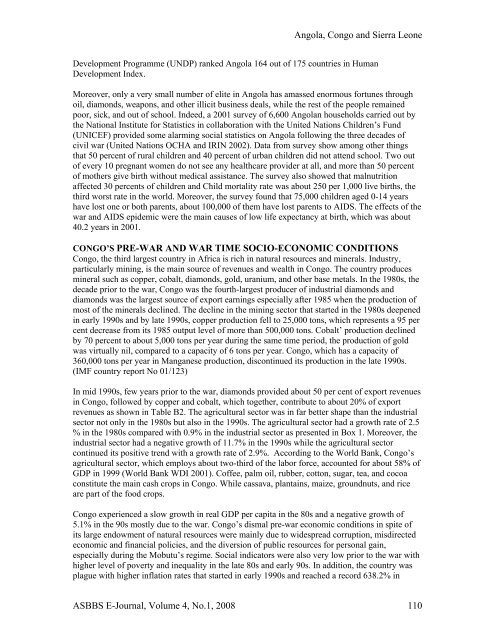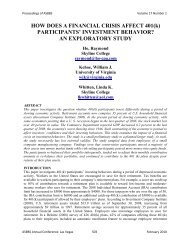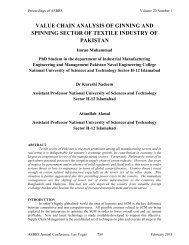stock repurchase announcements: a test of market ... - Asbbs.org
stock repurchase announcements: a test of market ... - Asbbs.org
stock repurchase announcements: a test of market ... - Asbbs.org
Create successful ePaper yourself
Turn your PDF publications into a flip-book with our unique Google optimized e-Paper software.
Angola, Congo and Sierra Leone<br />
Development Programme (UNDP) ranked Angola 164 out <strong>of</strong> 175 countries in Human<br />
Development Index.<br />
Moreover, only a very small number <strong>of</strong> elite in Angola has amassed enormous fortunes through<br />
oil, diamonds, weapons, and other illicit business deals, while the rest <strong>of</strong> the people remained<br />
poor, sick, and out <strong>of</strong> school. Indeed, a 2001 survey <strong>of</strong> 6,600 Angolan households carried out by<br />
the National Institute for Statistics in collaboration with the United Nations Children’s Fund<br />
(UNICEF) provided some alarming social statistics on Angola following the three decades <strong>of</strong><br />
civil war (United Nations OCHA and IRIN 2002). Data from survey show among other things<br />
that 50 percent <strong>of</strong> rural children and 40 percent <strong>of</strong> urban children did not attend school. Two out<br />
<strong>of</strong> every 10 pregnant women do not see any healthcare provider at all, and more than 50 percent<br />
<strong>of</strong> mothers give birth without medical assistance. The survey also showed that malnutrition<br />
affected 30 percents <strong>of</strong> children and Child mortality rate was about 250 per 1,000 live births, the<br />
third worst rate in the world. Moreover, the survey found that 75,000 children aged 0-14 years<br />
have lost one or both parents, about 100,000 <strong>of</strong> them have lost parents to AIDS. The effects <strong>of</strong> the<br />
war and AIDS epidemic were the main causes <strong>of</strong> low life expectancy at birth, which was about<br />
40.2 years in 2001.<br />
CONGO’S PRE-WAR AND WAR TIME SOCIO-ECONOMIC CONDITIONS<br />
Congo, the third largest country in Africa is rich in natural resources and minerals. Industry,<br />
particularly mining, is the main source <strong>of</strong> revenues and wealth in Congo. The country produces<br />
mineral such as copper, cobalt, diamonds, gold, uranium, and other base metals. In the 1980s, the<br />
decade prior to the war, Congo was the fourth-largest producer <strong>of</strong> industrial diamonds and<br />
diamonds was the largest source <strong>of</strong> export earnings especially after 1985 when the production <strong>of</strong><br />
most <strong>of</strong> the minerals declined. The decline in the mining sector that started in the 1980s deepened<br />
in early 1990s and by late 1990s, copper production fell to 25,000 tons, which represents a 95 per<br />
cent decrease from its 1985 output level <strong>of</strong> more than 500,000 tons. Cobalt’ production declined<br />
by 70 percent to about 5,000 tons per year during the same time period, the production <strong>of</strong> gold<br />
was virtually nil, compared to a capacity <strong>of</strong> 6 tons per year. Congo, which has a capacity <strong>of</strong><br />
360,000 tons per year in Manganese production, discontinued its production in the late 1990s.<br />
(IMF country report No 01/123)<br />
In mid 1990s, few years prior to the war, diamonds provided about 50 per cent <strong>of</strong> export revenues<br />
in Congo, followed by copper and cobalt, which together, contribute to about 20% <strong>of</strong> export<br />
revenues as shown in Table B2. The agricultural sector was in far better shape than the industrial<br />
sector not only in the 1980s but also in the 1990s. The agricultural sector had a growth rate <strong>of</strong> 2.5<br />
% in the 1980s compared with 0.9% in the industrial sector as presented in Box 1. Moreover, the<br />
industrial sector had a negative growth <strong>of</strong> 11.7% in the 1990s while the agricultural sector<br />
continued its positive trend with a growth rate <strong>of</strong> 2.9%. According to the World Bank, Congo’s<br />
agricultural sector, which employs about two-third <strong>of</strong> the labor force, accounted for about 58% <strong>of</strong><br />
GDP in 1999 (World Bank WDI 2001). C<strong>of</strong>fee, palm oil, rubber, cotton, sugar, tea, and cocoa<br />
constitute the main cash crops in Congo. While cassava, plantains, maize, groundnuts, and rice<br />
are part <strong>of</strong> the food crops.<br />
Congo experienced a slow growth in real GDP per capita in the 80s and a negative growth <strong>of</strong><br />
5.1% in the 90s mostly due to the war. Congo’s dismal pre-war economic conditions in spite <strong>of</strong><br />
its large endowment <strong>of</strong> natural resources were mainly due to widespread corruption, misdirected<br />
economic and financial policies, and the diversion <strong>of</strong> public resources for personal gain,<br />
especially during the Mobutu’s regime. Social indicators were also very low prior to the war with<br />
higher level <strong>of</strong> poverty and inequality in the late 80s and early 90s. In addition, the country was<br />
plague with higher inflation rates that started in early 1990s and reached a record 638.2% in<br />
ASBBS E-Journal, Volume 4, No.1, 2008 110

















